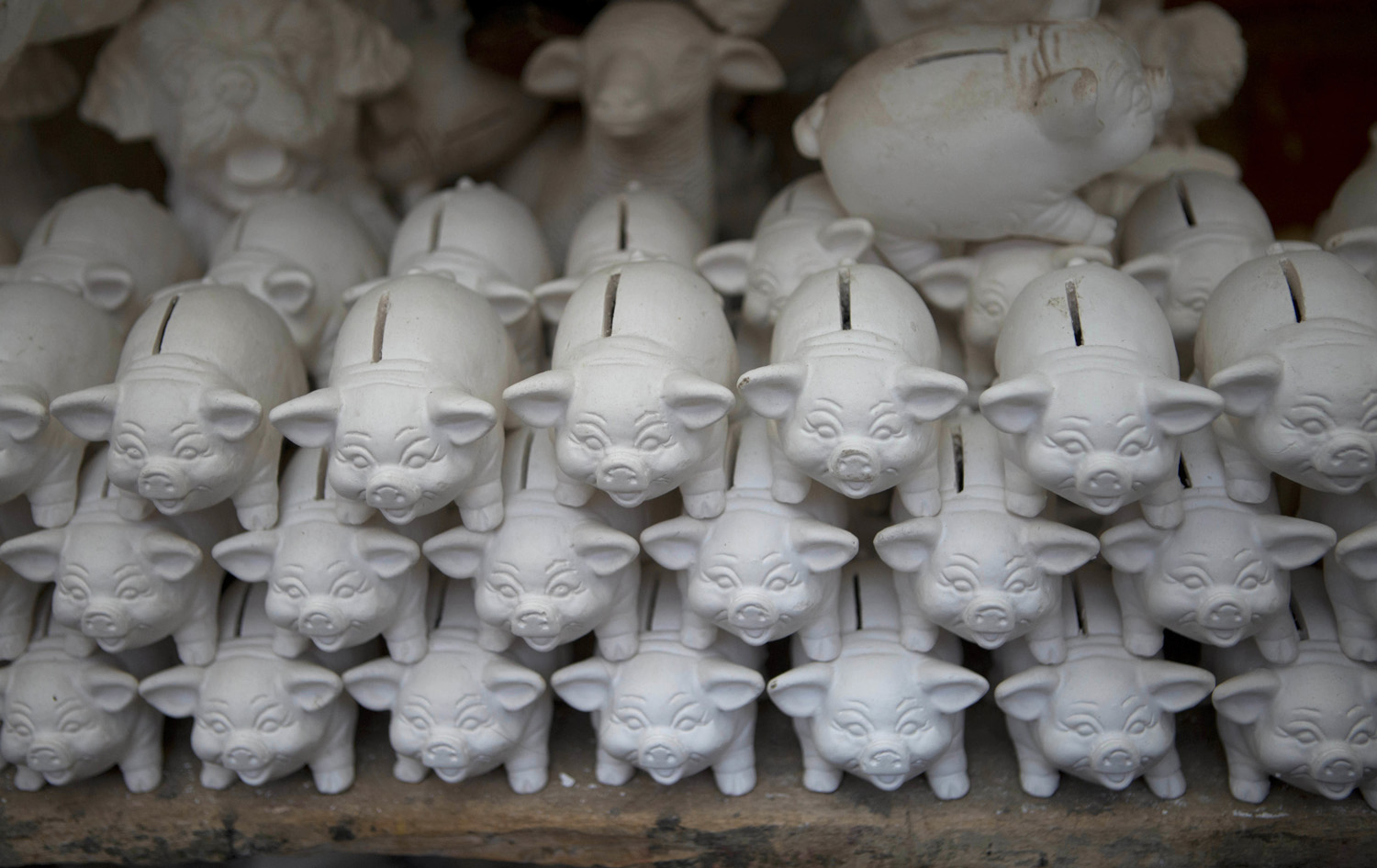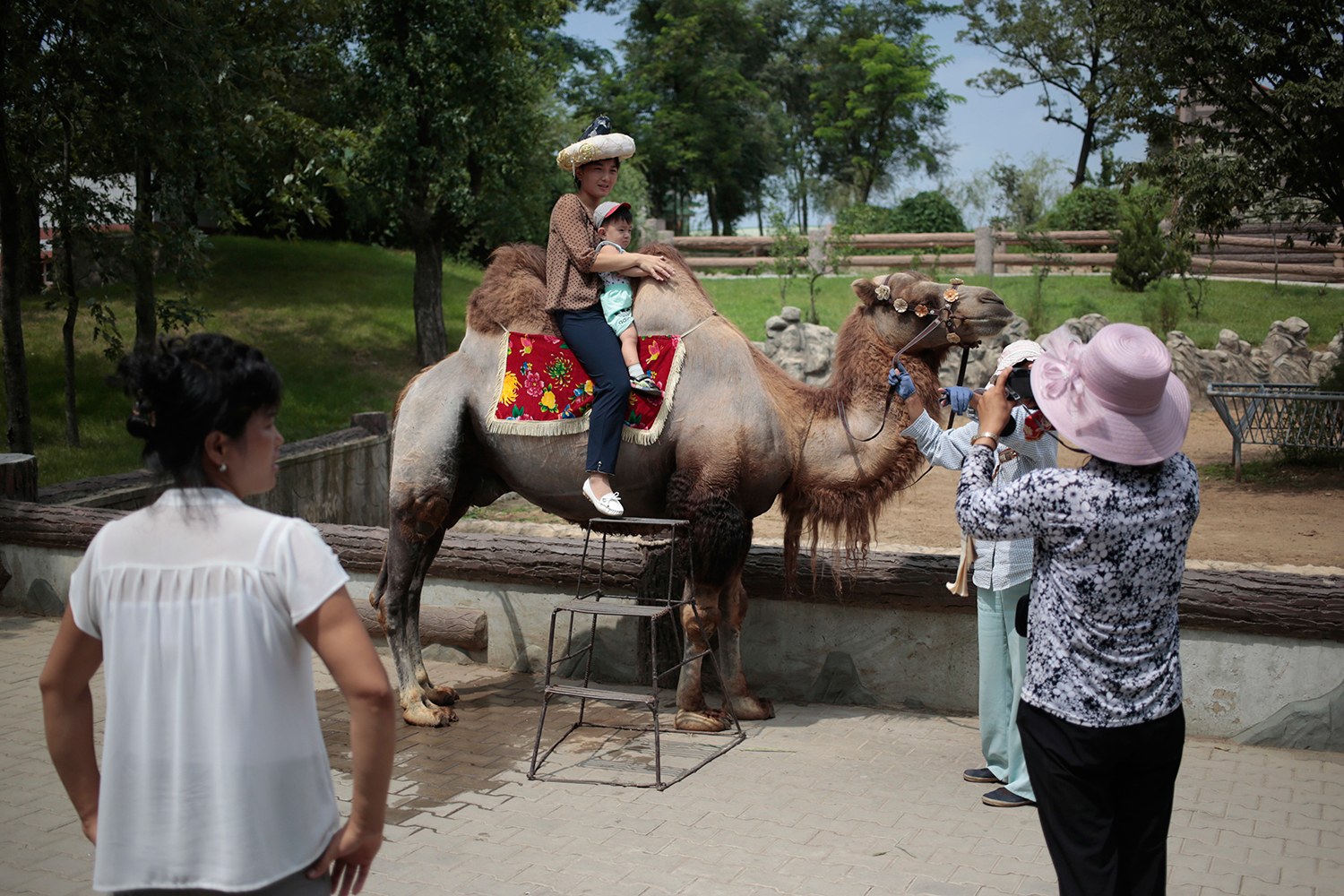As Indonesia cuts forests, fake nature thrives

Indonesia’s capital is lush with fake greenery even as the country is cutting down its precious tropical forests at a record rate.
Jakarta’s gleaming air-conditioned malls have a particular fondness for lifeless extravaganzas of plastic ferns or autumnal trees that don’t drop any leaves.
In this Thursday, Oct. 20, 2016 photo, shoppers walk past artificial trees at a shopping mall in Jakarta, Indonesia. The metropolitan's gleaming air conditioned malls have a particular fondness for fake forests, erecting plastic ferny extravaganzas where no life thrives or autumnal trees that don't drop any leaves while environmental destruction taking place elsewhere in the nation as palm oil and pulp wood plantations consume ever more land. (AP Photo/Dita Alangkara)
Construction sites are wrapped in screens printed with giant leaves glistening with dew drops or the picturesque deciduous forests found in temperate climates. A new terminal at the international airport has a mini-jungle within its cavernous air-conditioned interior. Despite the odd inclusion of fake grass it has the slight saving grace that the potted greenery is real.
It’s not that Jakarta lacks real trees. The presidential palace has well-manicured surrounds of park, verges and trees. But elsewhere, against the backdrop of unrelenting traffic and brutalist concrete, the greens often seem weirdly out of place, like an introduced alien species.
In this Wednesday, Oct. 26, 2016 photo, workers sweep dry leaves against the background of banners depicting a forest used to cover a construction site in Jakarta, Indonesia. One of the strange sights in Indonesia, an ecologically rich archipelago of more than 13,000 islands, is its capital's fondness for fake greenery at a time when the country is known for cutting down its precious tropical forests at a record rate. (AP Photo/Dita Alangkara)
“Shuttling between air-conditioned high rises decorated with a simulacrum of nature, it’s easy to ignore the impact on climate and communities of relentless forest destruction taking place far away,” said Greenpeace Indonesia campaigner Yuyun Indradi.
Indonesia’s most densely populated island, Java, is nearly completed denuded of its original virgin forest and Sumatra is nearly as bare. Palm oil and pulp wood plantation companies are now making inroads into the great forests of Borneo and Papua.
In this Wednesday, Oct. 12, 2016 photo, a man walks past a mural depicting coconut trees in Jakarta, Indonesia. One of the strange sights in Indonesia, an ecologically rich archipelago of more than 13,000 islands, is its capital's fondness for fake greenery at a time when the country is known for cutting down its precious tropical forests at a record rate. (AP Photo/Dita Alangkara)
The draining of tropical wetlands for industrial plantations has also come at a significant human cost. Record dry season fires in Sumatra and Borneo in 2015 hastened 100,000 deaths in the region from air pollution, according to a Harvard and Columbia study, and by World Bank estimates cost Indonesia’s economy $16 billion.
“Perhaps when our children grow up, fake trees may help them reflect on how badly we need to protect that which is authentic and can’t simply be purchased in a mall,” said Indradi. “Or will they decide that the more comfortable, accessible and colorful fake version will do them just as well?”
In this Tuesday, Nov. 15, 2016 photo, parking attendants chat near a banner covering a construction site at the main business district in Jakarta, Indonesia. One of the strange sights in Indonesia, an ecologically rich archipelago of more than 13,000 islands, is its capital's fondness for fake greenery at a time when the country is known for cutting down its precious tropical forests at a record rate. (AP Photo/Dita Alangkara)
The fake nature is of a piece with our world today. We live in an age when it’s sometimes increasingly difficult to discern the fake and the real.
Artificial flavorings. Perfectly photoshopped selfies to eliminate blemishes and extra weight. Sophisticated simulations of famous buildings in cities across the world — like the skyscrapers of New York dotting the casinos of Las Vegas.
In this Tuesday, May 16, 2017 photo, a woman walks past banners covering a construction site in Jakarta, Indonesia. One of the strange sights in Indonesia, an ecologically rich archipelago of more than 13,000 islands, is its capital's fondness for fake greenery at a time when the country is known for cutting down its precious tropical forests at a record rate. (AP Photo/Dita Alangkara)
In Japan, there’s an entire street that sells plastic food meticulously designed to make potential restaurant-goers’ mouths water. In some well-to-do gated communities in the United States, gardens are full of fake flowers carefully drizzled with transparent glue so that they look as if they’ve been freshly rained upon.
And then there’s fake news, of course — the latest expression of something synthetic that has people talking and arguing over its very definition.
In this Friday, March 3, 2017 photo, Muslim women stand inside an elevator decorated with tree wallpapers at a hospital in Jakarta, Indonesia. One of the strange sights in Indonesia, an ecologically rich archipelago of more than 13,000 islands, is its capital's fondness for fake greenery at a time when the country is known for cutting down its precious tropical forests at a record rate. (AP Photo/Dita Alangkara)
In this Friday, April 28, 2017 photo, workers take a break at an artificial garden at the newly-opened Terminal 3 at Soekarno-Hatta International Airport in Tangerang, Indonesia. The urban embellishments creates an irony as environmental destructions are taking place elsewhere in the nation. Record forest fires in Sumatra and Kalimantan in 2015, often set to clear land for plantations, hastened tens of thousands of deaths from air pollution, according to a Harvard and Columbia study, and by World Bank estimates cost $16 billion. (AP Photo/Dita Alangkara)
In this Friday, Oct. 14, 2016 photo, a coffee vendor waits for customers near a patch of metal sheets adorned with stickers depicting a forest used to cover a construction site in Jakarta, Indonesia. The capital's fondness for fake greenery creates a n irony as the country is known for cutting down its precious tropical forests at a record rate. (AP Photo/Dita Alangkara)
It makes sense, though, that fake nature would assert itself, just as real nature does, in the in-between spaces of Jakarta. Human beings are inclined to simulate what they can’t have.
In this Saturday, Nov. 12, 2016 photo, a man walks past a wall decorated with artificial plants at a shopping mall in Jakarta, Indonesia. The metropolitan's gleaming air conditioned malls have a particular fondness for fake trees and forests, creating an irony as the country is known for cutting down its precious tropical forests at a record rate. (AP Photo/Dita Alangkara)
In this Tuesday, March 28, 2017 photo, shoppers take a break under artificial trees at a shopping mall in Jakarta, Indonesia. The metropolitan's gleaming air conditioned malls have a particular fondness for fake trees and forests, creating an irony as the country is known for cutting down its precious tropical forests at a record rate. (AP Photo/Dita Alangkara)
In this Saturday, April 15, 2017 photo, people take an escalator adorned with environmental awareness message at a shopping mall in Jakarta, Indonesia. One of the strange sights in Indonesia, an ecologically rich archipelago of more than 13,000 islands, is its capital's fondness for fake greenery at a time when the country is known for cutting down its precious tropical forests at a record rate. (AP Photo/Dita Alangkara)
In this Sunday, April 16, 2017 photo, guests sit under an artificial tree during a wedding party in Jakarta, Indonesia. One of the strange sights in Indonesia, an ecologically rich archipelago of more than 13,000 islands, is its capital's fondness for fake greenery at a time when the country is known for cutting down its precious tropical forests at a record rate. (AP Photo/Dita Alangkara)
In this Wednesday, Oct. 12, 2016 photo, passengers sit inside a city bus as it drives past a mural depicting coconut trees in Jakarta, Indonesia. One of the strange sights in Indonesia, an ecologically rich archipelago of more than 13,000 islands, is its capital's fondness for fake greenery at a time when the country is known for cutting down its precious tropical forests at a record rate. (AP Photo/Dita Alangkara)
In this Thursday, Nov. 10, 2016 photo, a motorist rides past a construction site covered with metal sheets decorated with large stickers depicting greeneries at the main business district in Jakarta, Indonesia. One of the strange sights in Indonesia, an ecologically rich archipelago of more than 13,000 islands, is its capital's fondness for fake greenery at a time when the country is known for cutting down its precious tropical forests at a record rate. (AP Photo/Dita Alangkara)
Text from the AP news story, AP PHOTOS: As Indonesia cuts forests, fake nature thrives by Dita Alangkara.
Photos by Dita Alangkara
Follow AP photographers on Twitter
Written content on this site is not created by the editorial department of AP, unless otherwise noted.





